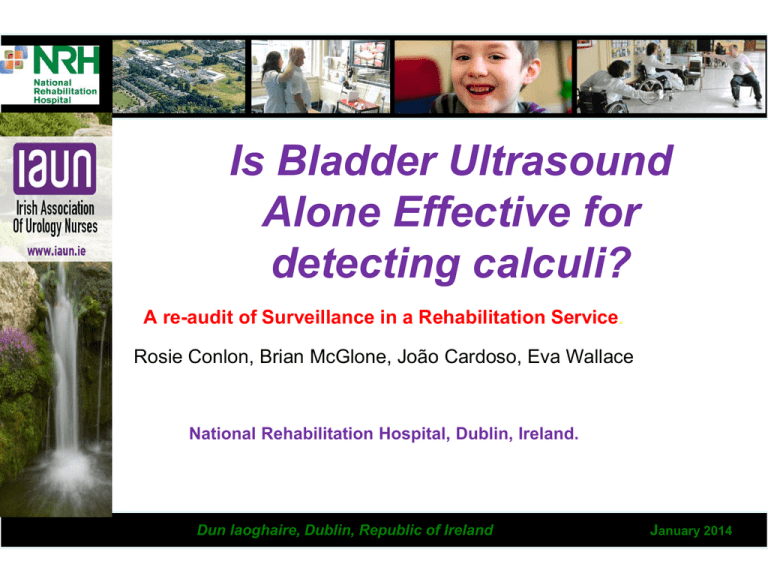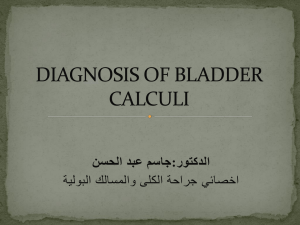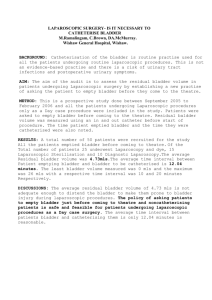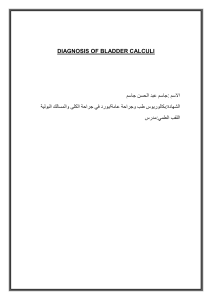Is Bladder Ultrasound Alone Effective for detecting calculi?
advertisement

Is Bladder Ultrasound Alone Effective for detecting calculi? A re-audit of Surveillance in a Rehabilitation Service. Rosie Conlon, Brian McGlone, João Cardoso, Eva Wallace National Rehabilitation Hospital, Dublin, Ireland. Dun laoghaire, Dublin, Republic of Ireland January 2014 Background Urinary Tract Infections (UTI) are the most frequent medical complication in patients with Spinal Cord Injuries (SCI) and a major cause of morbidity The main purpose of regular urology review (Nurse -led clinic NLC) is to preserve renal function with the ultimate aim of a non obstructed urinary system SCI patients with bladder catheter have a 9-fold risk for bladder stones, compared to the catheter free patients with spinal cord injury Objectives • Re-audit the findings of ultrasound and X-ray, • Explore the possibility of reducing exposure to radiation • Examine the relationship between bladder calculi, bladder management technique and symptoms Methods: 28 patients, over a 12 months period, were found to have urinary bladder calculi at routine urology review. Results Bladder Management Technique Numbers in patients with bladder stones Bladder Management Technique Percentages in patients with bladder stones 12 12 10 8 8 3% 6 11% 4 3% 43% 3 3 2 1 1 0 29% 11% Supra Pubic Catheterization (SPC) Self Intermittent Catheterization (SIC) Indwelling Urethral Catheterization (IDUC) Conveen Pads Continent 4 Results Bladder ultrasound alone diagnosed 36 % bladder calculi compared to 18% diagnosed by X-ray alone Symptoms and Signs Urinalysis taken on all patients. Proteus is the microbe commonly associated with the formation of calculi and is not a common microbe in SCI patients. E-coli is a common uro-pathogen, often recurrent and asymptomatic Urinalysis 6/28 patients (21.4%) had no growth, colony count < 1000 cfu/ml. 22/28 patients (78.6%) had significant culture. Of these: Significant Urine culture results Number of cases Percentage E-coli 12 42,8% Coli form bacteria 3 10,7% Proteus 1 2,8% Enterococcus 1 2,8% Pseudomonas 1 2,8% 1 2,8% 3 14,3% Marginella marganil (isolated and multi resistant ? due to catheter colonisation) Mixed growth 7 …. Should we change our current practice?? “An important concern with indwelling catheterization, whether transurethral or suprapubic, is the long-term risk of squamous cell bladder neoplasia (SCC). The reported incidence of SCC associated with chronic indwelling urinary catheters is 2.3-10%.” [2] Saline infusion of 100-200mls in a controlled environment may allow visualisation of calculi by US and avoid exposure to radiation in this higher risk group of patients. Autonomic Dysreflexia • Risk of Autonomic Dysreflexia (AD) with saline infusion of approx 200mls to distend the bladder for examination with ultrasound. • Bladder distension below the level of SCI for those with T6 injury or above can cause AD • If recognised quickly and appropriate action taken, the symptoms subside and reduce the risk of complication • Risk of introducing infection 9 Conclusions • Our patients have a higher incidence of calculi than the general population, ultrasound is the modality of choice for detecting calculi • Most patients are asymptomatic with calculi • Routine surveillance is warranted • Change in practice should reduce the overall radiation exposure to patients at greatest risk of bladder stone formation and SCC • Further audit required 10 “Bones can break, muscles can atrophy, glands can loaf about and even the brain can sleep without immediate danger to survival. BUT when the kidneys fail…. neither bone, muscle gland nor brain could carry on.” Homer William Smith, “The Evolution of the Kidney”, Lectures on the Kidney (1943). 11 References • [1] Chen • [2] Kaufman Y, De Vivo MJ, Lloyd LK. Bladder stone incidence in persons with SCI: Determinants and trends, 1973-1996. Urology 2001;58(5)665-70. JM, Fam B, Jacobs SC et al. Bladder cancer and squamous metaplasia in spinal cord injury patients. J Urol 1977; 118: 967, 1390, 19876. 12











